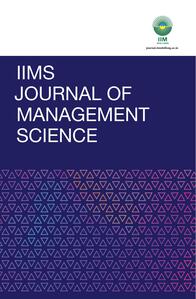
1 St. Xavier’s College (Autonomous), Kolkata, West Bengal, India
2 Department of Commerce (Evening), St. Xavier’s College (Autonomous), Kolkata, West Bengal, India
3 Department of Commerce (Morning), St. Xavier’s College (Autonomous), Kolkata, West Bengal, India
4 Deparment of Commerce and Management, St. Xavier’s University, Kolkata, West Bengal, India
Creative Commons Non Commercial CC BY-NC: This article is distributed under the terms of the Creative Commons Attribution-NonCommercial 4.0 License (http://www.creativecommons.org/licenses/by-nc/4.0/) which permits non-Commercial use, reproduction and distribution of the work without further permission provided the original work is attributed as specified on the SAGE and Open Access pages (https://us.sagepub.com/en-us/nam/open-access-at-sage).
The astounding proliferation of mobile internet and technological innovations is one of the revelations of the 21st-century modern world. Electronic gadgets such as smartphones and tablets possess bewildering and alluring features which when blended with internet gives the modus vivendi of the consumers a completely different meaning. It has been observed that consumers have shown a strong penchant toward such technological vantages and innovative gadgets. In this context, the rise in the usage of music apps has been driven largely by the skyrocketing in the production and use of smartphones, coupled with the landscape of fast-paced internet. There are large number of consumers who have been adopting and using music apps, especially during the boring and monotonous period of COVID-19. The current research study is attempted at examining and analyzing the attitudes and behavior of the consumers toward the use of such music apps. For this purpose, a survey has been conducted in selected districts of West Bengal on the basis of “technology acceptance model”. The results reveal that consumers of West Bengal have positive perception toward music apps.
COVID-19 pandemic, mobile commerce, music apps, attitudes and behavior, technology acceptance model (TAM)
JEL Classification: M31, O33, O31
Ajzen, I., & Fishbein, M. (1980). Understanding attitudes and predicting social behaviour. Prentice Hall.
Ajzen, I., & Fishbein, M. (2000). Attitudes and the attitude-behavior relation: Reasoned and automatic processes. European Review of Social Psychology, 11(1), 1–33. https://doi.org/10.1080/14792779943000116
Davis, F. D. (1989). Perceived usefulness, perceived ease of use, and user acceptance of Information Technology. MIS Quarterly, 13(3), 319–340. https://doi.org/10.2307/249008
Davis, F. D. (1993). User acceptance of information technology: System characteristics, user perceptions and behavioural impacts. International Journal of Man-Machine Studies, 38(3), 475–487. https://doi.org/10.1006/imms.1993.1022
Davis, F. D., Bagozzi, R. P., & Warshaw, P. R. (1989). User acceptance of computer technology: A comparison of two theoretical models. Management Science, 35(8), 982–1003. https://doi.org/10.1287/mnsc.35.8.982
Fornell, C., & Larcker, D. F. (1981). Structural equation models with unobservable variables and measurement error: Algebra and statistics. Journal of Marketing Research, 18(3), 382–388. https://doi.org/10.1177/002224378101800313
Luam, P., & Lin, H. H. (2004). Towards an understanding of the behavioral intention to use mobile banking. Computers in Human Behavior, 21(6), 340–348.
Pavez, T. (2021). Music streaming trends and music services in India: An overview. SonoSuite. http://www.sonosuite.com/blog/music-streaming-trends-in-india/
Roy, S. (2017). Scrutinizing the factors influencing customer adoption of app-based cab services: An application of the technology acceptance model. IUP Journal of Marketing Management, 16(4), 54–69.
Srivastava, A. (2020). Market share of music streaming apps in India. AS. http://www.arpitsrivastava.com/market-share-of-music-streaming-apps-in-india/
Taylor, S., & Todd, P. A. (1995). Understanding Information Technology usage: A test of competing models. Information Systems Research, 6(2), 144–176. https://doi.org/10.1287/isre.6.2.144
Venkatesh, V., & Bala, H. (2008). Technology acceptance Model 3 and a research agenda on interventions. Decision Sciences, 39(2), 273–315.
Venkatesh, V., & Davis, F. D. (2000). A theoretical extension of the technology acceptance model: Four longitudinal field studies. Management Science, 46(2), 186–204. https://doi.org/10.1287/mnsc.46.2.186.11926
Venkatesh, V., Morris, M. G., Davis, G. B., & Davis, F. D. (2003). User acceptance of Information Technology: Toward a unified view. MIS Quarterly, 27(3), 425–478. https://doi.org/10.2307/30036540